How to Create Memorable AI Characters : Step-by-Step IP Design Guide 2025

Hey there, creative minds! Welcome to our comprehensive guide on creating unforgettable AI characters using Lovart. Whether you're developing a virtual influencer, game character, or brand mascot, this guide will walk you through the entire process of AI character design with practical examples and expert tips.
In today's digital landscape, AI-generated characters are everywhere—from social media avatars to immersive storytelling experiences. But creating memorable characters that maintain their identity across different scenes and media can be challenging. That's where this guide comes in!
As Lovart's first design agent specialized in character creation, we'll show you how to craft characters with distinct personalities, visual consistency, and emotional appeal. Let's dive in!
Why AI Character Design Matters in 2025
Before we jump into the how-to, let's understand why AI character design has become so crucial in the creative industry:
- Digital Identity Creation: Characters are no longer just for entertainment—they represent brands, ideas, and even personal identities in digital spaces.
- Intellectual Property Value: Well-designed AI characters can become valuable IP assets that can be licensed, merchandised, or developed into larger franchises.
- Emotional Connection: Memorable characters forge deeper connections with audiences, making your content more engaging and shareable.
- Cross-Platform Versatility: A well-designed character can seamlessly transition across different media formats—from static images to animation and beyond.
Now, let's get into the step-by-step process of creating memorable AI characters with Lovart.
Step-by-Step IP Design Guide
Step 1: Define Your Character's Purpose and Identity
Every great character starts with a clear purpose. Before touching any AI tools, you need to establish why your character exists and what role they'll play.
Key Questions to Answer:
- Who is your target audience?
- What emotions should your character evoke?
- What values or ideas does your character represent?
- In what contexts will your character appear? (Social media, games, marketing materials, etc.)
- Will your character evolve over time or remain consistent?
This foundation will inform every design decision moving forward. Remember: a character designed for children's educational content will have vastly different requirements than one created for a cyberpunk gaming experience.
💡 Pro Tip: Create a simple one-page character brief that captures the essence of who your character is. This will serve as your North Star throughout the design process.
Example Prompt for Character Concept in Lovart
Create a character concept for "Nova," a friendly AI assistant specializing in creative tasks. Nova should embody innovation and artistic inspiration while appearing approachable and helpful. The character will be used across educational materials, app interfaces, and promotional content for a digital art platform aimed at teens and young adults. Nova should have a distinct silhouette and color palette that conveys creativity and technological advancement.
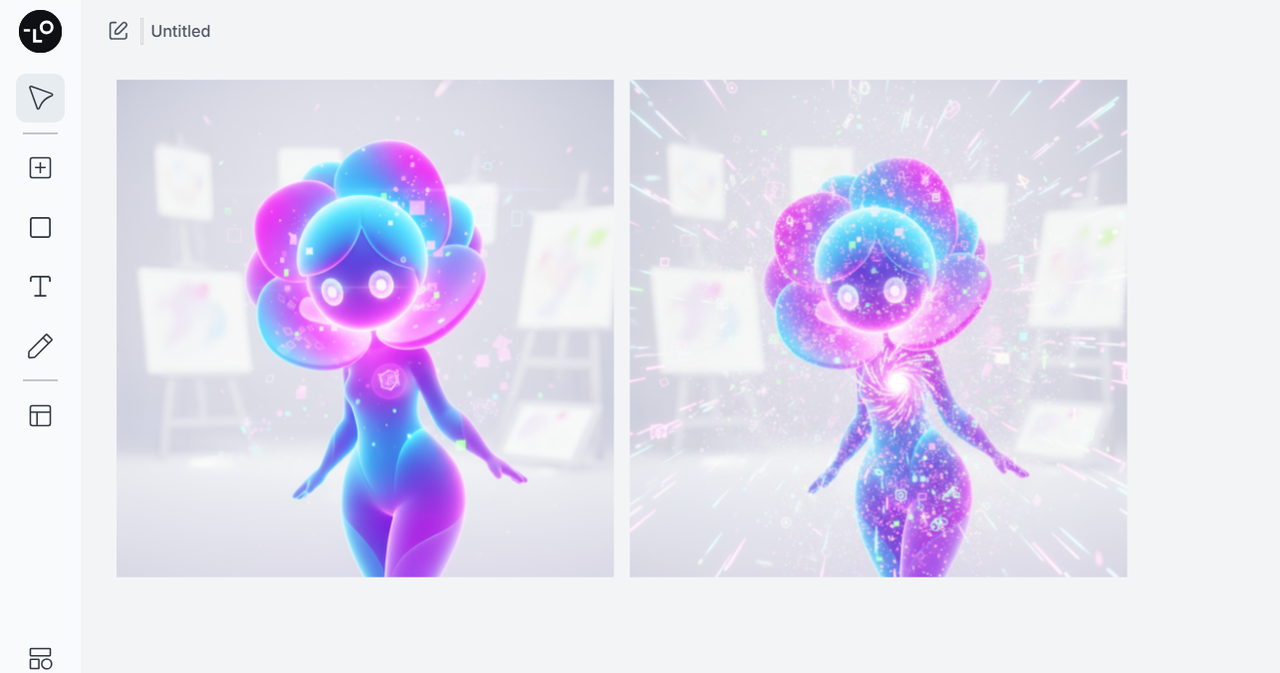
Step 2: Research and Gather Visual References
Even with AI tools, research remains essential. Gather visual inspiration that aligns with your character's purpose and identity. This step helps you articulate what you want more precisely when working with AI tools.
In Lovart, you can create a mood board directly in the workspace to collect reference images. This visual library will inform the AI about your aesthetic preferences and help maintain consistency.
Types of References to Collect:
- Style references: Art styles that match the tone you're aiming for
- Color palette inspiration: Colors that reflect your character's personality
- Character archetypes: Similar characters that evoke similar emotions
- Environmental contexts: Settings where your character will exist
- Pose and expression samples: How your character might move and emote
Example Prompt for Reference Gathering in Lovart
Create a mood board for my AI character "Nova" with the following reference categories:
- Modern digital art styles with clean lines and vibrant colors
- Friendly technology-themed characters with approachable features
- Color palettes featuring purples, blues, and warm accent colors
- Dynamic poses that convey helpfulness and energy
- UI/UX design elements that could be incorporated into the character's appearance
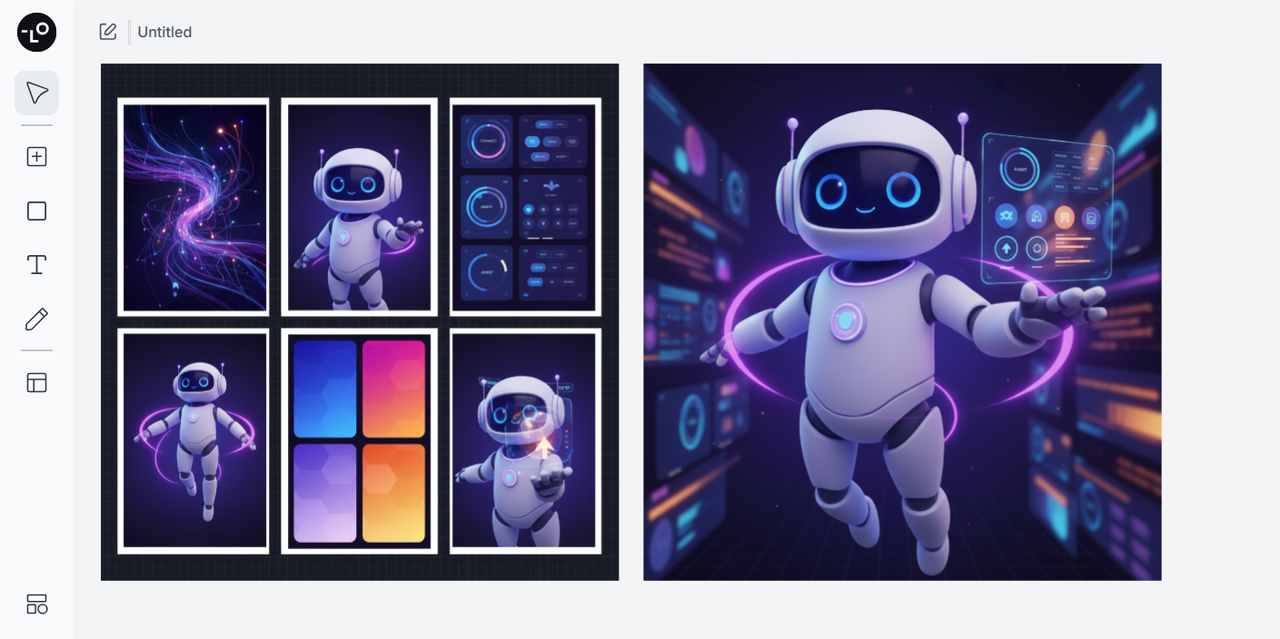
Step 3: Craft Your Character's Core Visual Identity
Now comes the exciting part—using AI to bring your character to life! With Lovart, you'll start by establishing your character's core visual identity. This includes their silhouette, proportions, facial features, and distinctive elements that make them immediately recognizable.
Remember, consistency is key in AI character design. You want your character to be recognizable even in different poses, lighting conditions, or emotional states.
| Visual Element | Purpose | Considerations |
|---|---|---|
| Silhouette | Instant recognition | Should be distinctive even in shadow form |
| Color Palette | Emotional association | Limit to 3-5 main colors for consistency |
| Proportions | Character type and age | Helps convey personality and role |
| Distinctive Features | Memorable traits | Unique elements that set your character apart |
| Expression Range | Emotional connection | How your character conveys feelings |
Example Prompt for Core Visual Identity in Lovart
Design the core visual identity for "Nova," featuring:
- A humanoid silhouette with slightly exaggerated proportions for a friendly appearance
- Primary color palette: deep purple base with electric blue accents and warm orange highlights
- Distinctive features: a glowing chest emblem, asymmetrical design elements, and expressive eyes that change color based on activity
- Clean, geometric design language with subtle organic curves
- Generate 3 variations maintaining these core elements but exploring different approaches
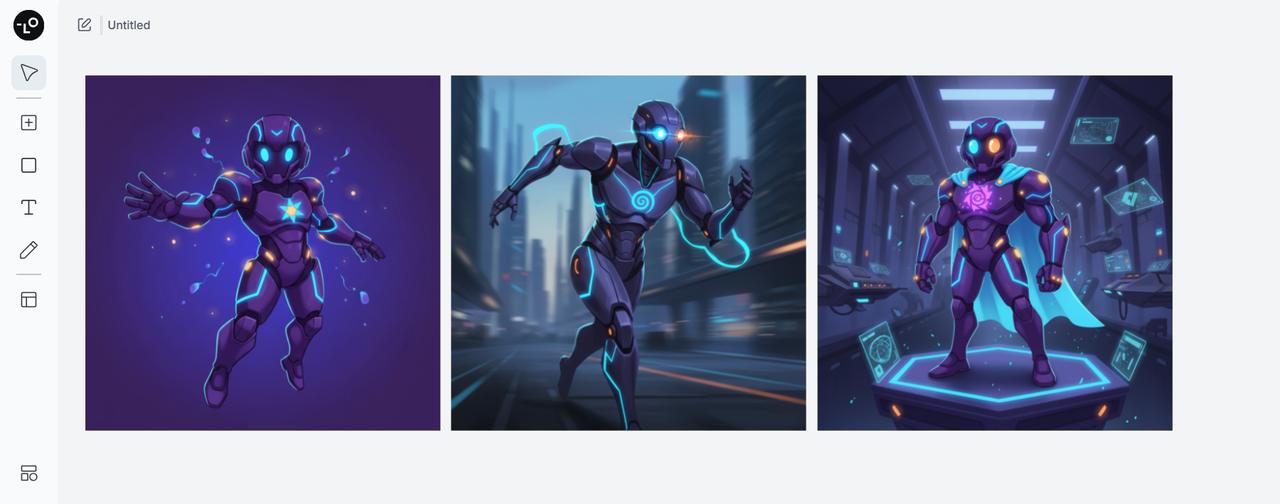
Step 4: Develop Your Character's Style Guide
To maintain consistency across different scenes and media, you need a character style guide. This document defines the rules for how your character looks from different angles, in different poses, and expressing different emotions.
With Lovart, you can generate a comprehensive style guide that serves as a reference for all future character iterations.
Essential Style Guide Components:
- Character turnarounds: Views from front, side, back, and 3/4 angles
- Expression sheet: Your character displaying various emotions
- Pose library: Common poses that reflect your character's personality
- Color specifications: Exact color values for consistent rendering
- Proportional guidelines: Key measurements and ratios
- Do's and don'ts: Rules for maintaining character integrity
🎨 Design Tip: Even minor inconsistencies can make your character feel "off" to viewers. A detailed style guide prevents this problem by establishing clear parameters.
Example Prompt for Style Guide Generation in Lovart
Create a comprehensive character style guide for Nova with:
- Turnaround sheet showing front, side, back, and 3/4 views with consistent proportions
- Expression sheet displaying 8 key emotions (happy, curious, thoughtful, excited, confused, focused, surprised, and relaxed)
- Color specifications including hex codes, RGB values, and appropriate gradients
- Three signature poses that demonstrate Nova's helpful and creative personality
- Proportional guidelines with head-to-body ratio and key feature measurements
- "Do's and Don'ts" section highlighting what aspects must remain consistent across all representations
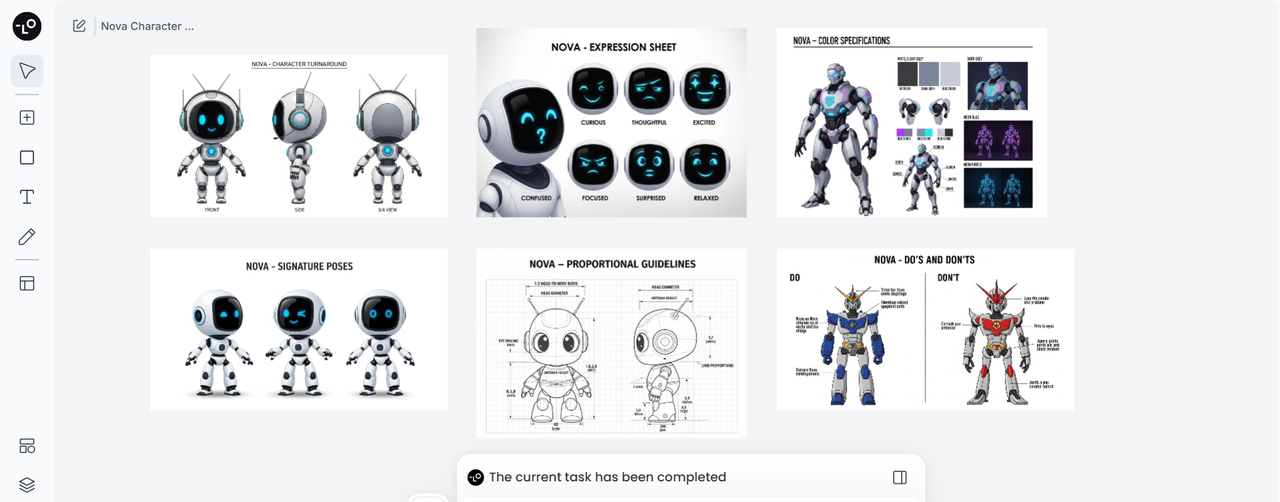
Step 5: Create Character Variations While Maintaining Identity
A truly versatile character needs to maintain their identity while adapting to different scenarios, outfits, or environments. This is where many AI-generated characters fall short—they look different each time they're rendered.
Lovart's advanced diffusion models help solve this problem by maintaining core identity traits while allowing for contextual variations.
Elements to Keep Consistent:
- Face structure and key features
- Body proportions
- Signature color palette
- Distinctive accessories or markings
- Overall silhouette
Elements That Can Vary:
- Clothing and outfits
- Poses and gestures
- Environmental context
- Lighting conditions
- Emotional expressions
Example Prompt for Character Variations in Lovart
Generate 4 variations of Nova maintaining core identity but showing different contexts:
- Nova in a creative workspace helping an artist, wearing casual-professional attire
- Nova in an outdoor educational setting with weather-appropriate accessories
- Nova in a futuristic tech environment with enhanced digital elements
- Nova in celebration mode with festive elements while maintaining signature silhouette and features
Ensure consistent facial structure, proportions, color palette, and distinctive features across all variations.
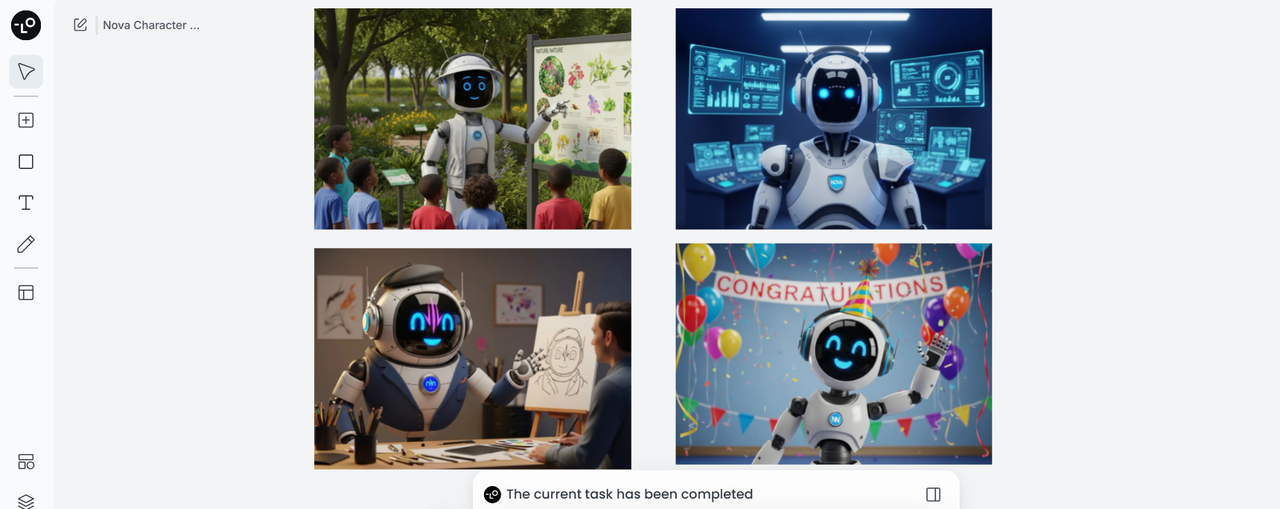
Step 6: Add Depth Through Backstory and Personality Traits
A visually striking character is good, but a character with depth is memorable. Use Lovart to develop a compelling backstory and personality traits that make your character three-dimensional.
Remember that visual design should reflect personality—a shy character might have different posture than an outgoing one; an intellectual might have different design elements than an action hero. Character Development Questions:
- What is your character's origin story?
- What motivates them? What do they fear?
- What are their strengths, weaknesses, and quirks?
- How do they speak? Do they have catchphrases?
- How do they change or grow over time?
Lovart can help you visualize these personality aspects through expressive imagery and scenario generation.
Example Prompt for Character Backstory in Lovart
Create a visual story sequence that illustrates Nova's backstory as a creative AI assistant:
- Nova's first awakening in a digital art studio, showing curiosity and wonder
- Nova learning to assist artists, displaying growing confidence
- A challenge moment where Nova overcomes a creative obstacle
- Nova today, confidently helping users while still maintaining a sense of wonder and creativity
Include brief narrative captions for each scene that highlight Nova's personality development, motivations, and core values.
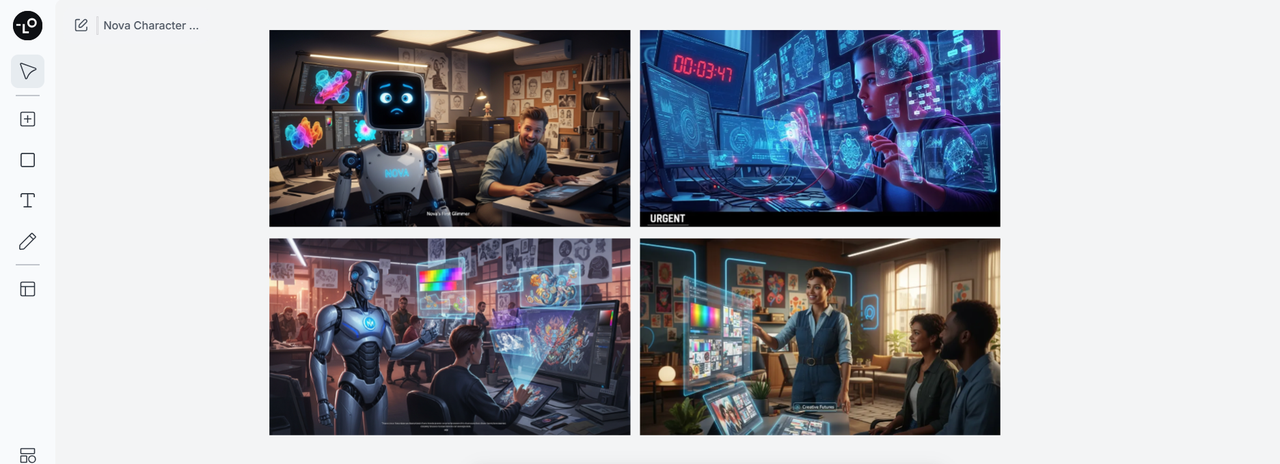
Step 7: Test Your Character in Different Scenarios
A well-designed character should work across various contexts and scenarios. Use Lovart to place your character in different situations to ensure they maintain their identity while adapting appropriately.
This testing phase helps identify any consistency issues before finalizing your character design.
Scenarios to Test:
- Different emotional states: How does your character express joy, sadness, anger, etc.?
- Various environments: How does your character look in different settings?
- Interaction with objects: Can your character handle props while maintaining their design integrity?
- Different media formats: How does your character translate to different styles (cartoon, realistic, etc.)?
- Action sequences: Can your character perform actions while remaining on-model?
🔍 Testing Tip: Pay special attention to how your character's distinctive features translate across different scenarios. These should remain recognizable even in dramatically different contexts.
Example Prompt for Scenario Testing in Lovart
Test Nova's character design across these diverse scenarios while maintaining core identity:
- Nova explaining a complex creative concept to a user (educational context)
- Nova celebrating a user's creative achievement (emotional context: excitement)
- Nova troubleshooting a technical problem (problem-solving context)
- Nova in a promotional header image for social media (marketing context)
For each scenario, analyze and identify which character elements remain consistent and which adapt to the context.
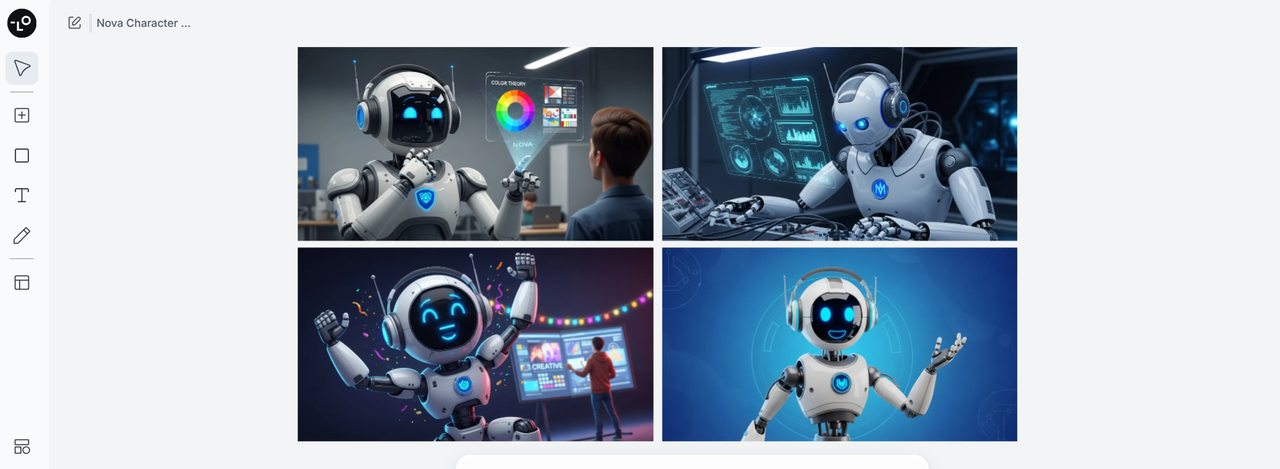
Step 8: Optimize for Different Media Formats
Your character may need to exist across various media formats—from static images to animations and perhaps even 3D models. Lovart can help you adapt your character design for different uses while maintaining its core identity.
| Media Format | Considerations | Optimization Tips |
|---|---|---|
| Static Images | Resolution, aspect ratio, detail level | Focus on silhouette and distinctive features |
| Social Media | Small display size, various crops | Simplify design, emphasize color and shape |
| Animation | Movement, expression range, consistency between frames | Create transition guides for key movements |
| 3D Models | Viewable from all angles, texture mapping | Ensure design works in three dimensions |
| Merchandise | Printability, simplification for products | Create simplified versions that maintain recognition |
Example Prompt for Media Format Optimization in Lovart
Optimize Nova's character design for these media formats:
- Social media profile picture (circular crop, high recognition at small size)
- Animated sequence showing Nova transitioning between helping states
- Simplified icon version for app buttons and small UI elements
- 3D model reference sheet with front, side, and perspective views
- Merchandise-ready design with simplified color blocks suitable for printing
For each format, maintain Nova's core identity features while optimizing for the specific requirements of the medium.
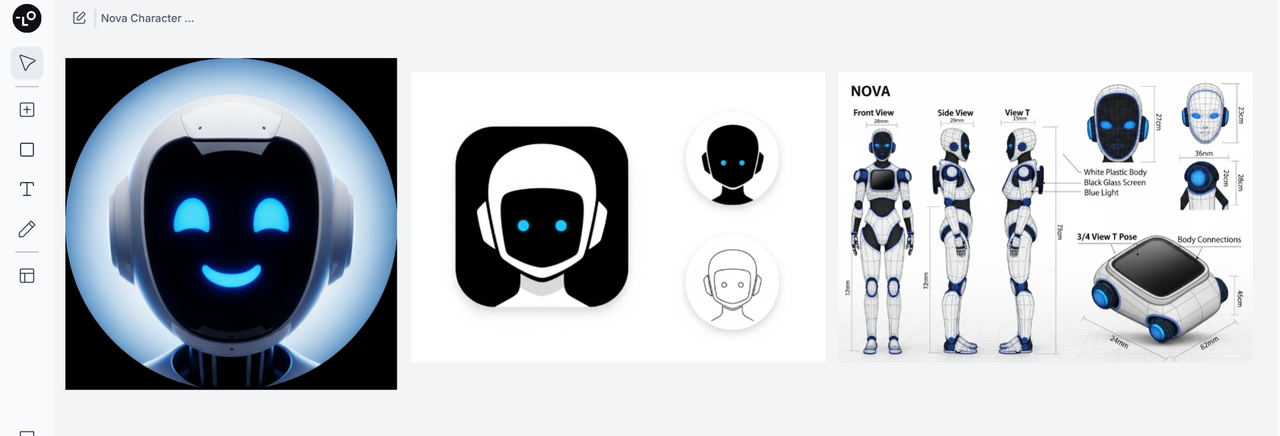
Step 9: Document and Protect Your IP
Once you've created your memorable AI character, it's important to document and protect your intellectual property. Lovart makes this easier by providing export options for all your character assets and documentation.
IP Protection Steps:
- Compile all character assets, including style guide, variations, and backstory
- Document your creative process and decision-making
- Consider copyright registration for original character designs
- Create usage guidelines for your character
- Maintain an archive of all official versions and appearances
📚 Legal Tip: AI-generated characters exist in a evolving legal landscape. While you can't copyright the AI's output directly in some jurisdictions, your creative direction, curation, and post-processing may be protectable. Consult with an IP attorney familiar with AI-generated content.
Example Prompt for IP Documentation in Lovart
Create a comprehensive IP documentation package for Nova that includes:
- A complete character bible with all visual assets, specifications, and guidelines
- Usage rights documentation template for different applications (marketing, merchandise, etc.)
- Visual timeline showing the character's development process
- Comparison sheet demonstrating Nova's unique features compared to similar characters in the market
- Archive-ready collection of all approved character variations with metadata and date stamps
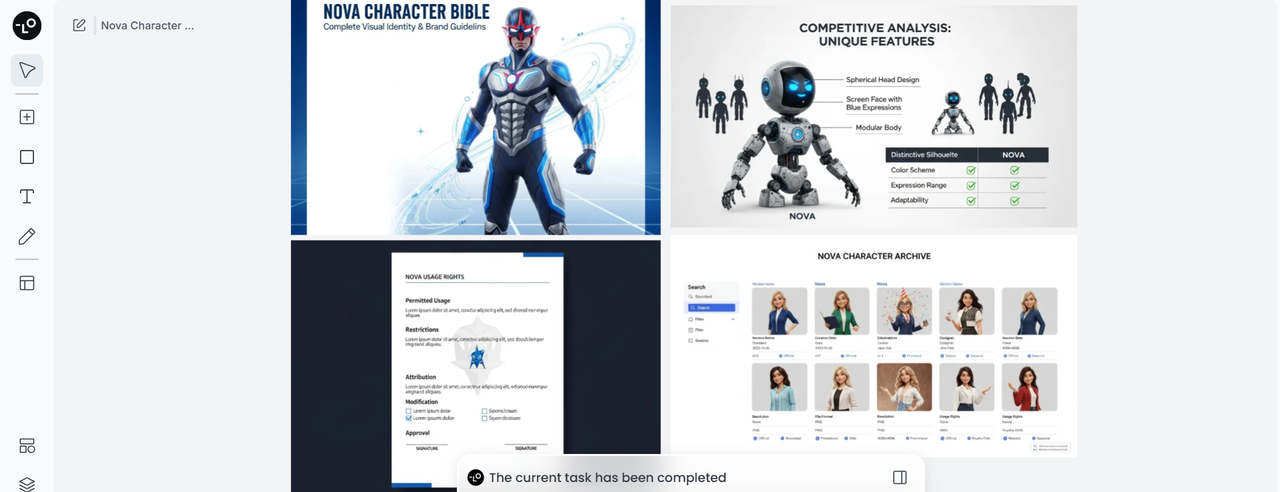
Character Design Showcase: Before and After
Let's see how applying these principles transforms an ordinary AI character into a memorable one:
| Before: Basic AI Character | After: Memorable IP Asset |
|---|---|
| Generic description with minimal details | Detailed identity with distinctive visual features |
| Inconsistent appearance across iterations | Strong visual continuity with adaptive flexibility |
| Flat personality without backstory | Rich character development with motivations and growth |
| Limited to one context or medium | Versatile across multiple scenarios and formats |
| No style guide or documentation | Comprehensive style guide and IP protection |
Common Challenges in AI Character Design (And How to Solve Them)
Even with powerful tools like Lovart, you'll encounter challenges in your AI character design journey. Here's how to overcome the most common ones:
Challenge: Maintaining Facial Consistency
- Solution: Use reference-based generation with a clear facial portrait as your anchor. Be extremely specific about distinctive facial features in your prompts. Consider using ControlNet for faces to lock in key features.
Challenge: Character Looks Different in Various Poses
- Solution: Create a posing guide with approved variations. Use prompt chaining—gradually change only one element at a time between generations. Focus on maintaining signature elements regardless of pose.
Challenge: Losing Character Identity in Action Scenes
- Solution: Break down action into keyframes. Emphasize your character's most distinctive traits in the prompt. Use latent space consistency techniques to preserve identity while adding motion.
Challenge: Translating Between 2D and 3D
- Solution: Design with dimensionality in mind from the start. Test your character from multiple angles early in the process. Create reference sheets specifically for 3D modeling.
Conclusion: From AI Generation to Memorable Character
Creating truly memorable AI characters is a blend of technology and creativity. While Lovart provides powerful tools for generating and maintaining visual consistency, the heart of character design remains your creative vision.
Remember that the most iconic characters—whether AI-generated or traditionally designed—connect with audiences through their distinctive visual appeal, personality depth, and consistent presence across different contexts.
By following this step-by-step guide, you've learned how to:
- Define a clear purpose and identity for your character
- Develop a distinctive visual style that stands out
- Create comprehensive documentation to maintain consistency
- Test and optimize your character across different scenarios
- Use advanced techniques to ensure professional-level consistency
- Protect your character as valuable intellectual property
Now it's your turn to bring memorable AI characters to life with Lovart. Whether you're creating for entertainment, education, marketing, or personal projects, these techniques will help you develop characters that resonate with audiences and stand the test of time.
Happy creating!

Partager l'Article